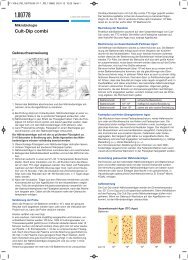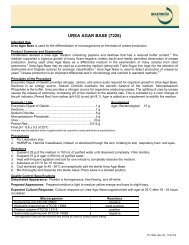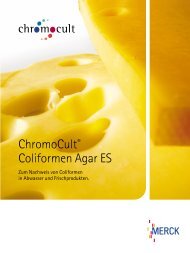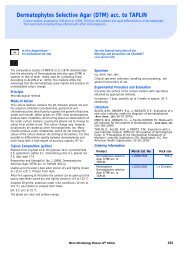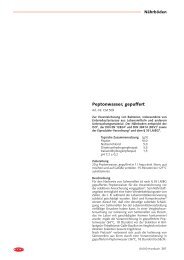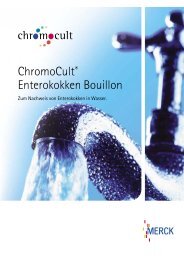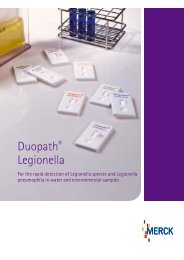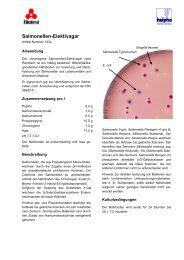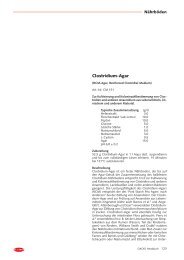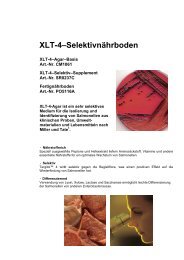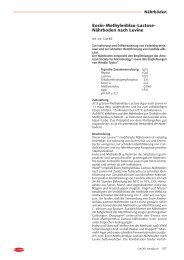TCBS Agar (Vibrio Selective Agar) - mibius
TCBS Agar (Vibrio Selective Agar) - mibius
TCBS Agar (Vibrio Selective Agar) - mibius
- No tags were found...
Create successful ePaper yourself
Turn your PDF publications into a flip-book with our unique Google optimized e-Paper software.
AOACBAMCOMPFISOSMWW<strong>TCBS</strong> <strong>Agar</strong> (<strong>Vibrio</strong> <strong>Selective</strong> <strong>Agar</strong>)Thiosulfate Citrate Bile Sucrose <strong>Agar</strong>Thiosulfate Citrate Bile Sucrose <strong>Agar</strong> proposed by NAKANISHI (1962), modified by KOBAYASHI et al. (1963) is used forthe isolation and selective cultivation of <strong>Vibrio</strong> cholerae and other enteropahtogenic vibrios (V. parahaemolyticus, NAGvibrios).<strong>TCBS</strong> <strong>Agar</strong> (<strong>Vibrio</strong> <strong>Selective</strong> <strong>Agar</strong>)Thiosulfate Citrate Bile Sucrose <strong>Agar</strong>in vitro diagnosticum –For professional use onlySee also General Instruction of UseWarnings and precautions see ChemDAT®(www.chemdat.info)This culture medium complies with the recommendations of theWorld Health Organization WHO (1965, 1967) and the APHA(1992).PrincipleMicrobiological methodMode of ActionThe high concentrations of thiosulfate and citrate and the strongalkalinity of this medium largely inhibit the growth of Enterobacteriaceae.Ox bile and cholate suppress primarily enterococci.Any coliform bacteria, which may grow, cannot metabolizesucrose. Only a few sucrose-positive Proteus strains can grow toform yellow, vibrid-like colonies. The mixed indicator thymolblue-bromothymol blue changes its colour to yellow, when acidis formed, even in this strongly alkaline medium.Typical Composition (g/litre)Peptone from casein 5.0; peptone from meat 5.0; yeast extract5.0; sodium citrate 10.0; sodium thiosulfate 10.0; ox bile 5.0;sodium cholate 3.0; sucrose 20.0; sodium chloride 10.0; iron(III)citrate 1.0; thymol blue 0.04; bromothymol blue 0.04; agar-agar14.0.Preparation and StorageCat. No. 1.10263. <strong>TCBS</strong> <strong>Agar</strong> (<strong>Vibrio</strong> <strong>Selective</strong> <strong>Agar</strong>) (500 g)Usable up to the expiry date when stored dry and tightly closedat +15 to +25° C. Protect from light.After first opening of the bottle the content can be used up to theexpiry date when stored dry and tightly closed at +15 to +25° C.Suspend 88 g/litre and pour plates.• Do not autoclave.pH: 8.6 ± 0.2 at 25 °C.The plates are clear and green-blue.Specimene.g. StoolClinical specimen collection, handling and processing, seegeneral instructions of use.Experimental Procedure and EvaluationInoculate by spreading the sample or material from an enrichmentculture, Alkaline Peptone water, on the surface of theplates.Incubation: 18-24 hours at 35 °C aerobically.According to BURKHARDT (1969), it is advised to use, inaddition to a liquid enrichment medium, two different solidculture media - a highly selective (e.g. <strong>TCBS</strong> <strong>Agar</strong>) and a lessselective culture medium (e.g. Nutrient <strong>Agar</strong>: Merck Cat.No.1.05450.).Appearance of ColoniesAppearance of ColoniesFlat, 2-3 mm in diameter,yellowSmall, blue-green centreLarge, yellowBlueVery small, translucentMicroorganismsMicroorganisms<strong>Vibrio</strong> cholerae, <strong>Vibrio</strong> choleraetype El Tor<strong>Vibrio</strong> parahaemolyticus<strong>Vibrio</strong> alginolyticusPseudomonas, Aeromonas andothersEnterobacteriaceae and othersFurther tests are necessary for complete identification (MUCKER-JEE 1961, FINKELSTEIN and MUCKERJEE 1963, ROY et al. 1965,BOCKEMÜHL 1974 etc.).LiteratureAmerican Public Health Association: Compendium of methods for themicrobiological examination of foods. – 3 rd edition (1992).BOCKEMÜHL, J.: Einfache Laboratoriumsdiagnostik der El Tor-Cholera.- Ärztl. Lab., 20; 32-41 (1974).BURKHARDT, F.: Die bakteriologische Diagnose der <strong>Vibrio</strong> El Tor-Infektion.- Zbl. Bakt. I. Orig., 212 ; 177-189 (1969).FINKELSTEIN, R.A., a. MUCKERJEE, S.: Haemagglutination a rapid methodfor differentiating V. cholerae and El Tor vibrios. - Proc. Soc. Exp. Biol. 112;335-359 (1963).KAMPELMACHER, E.H., MOSSEL, D.A.A., VAN NOORLE-JANSEN, a. VIN-CENTIE, H.: A survey on the occurrence of <strong>Vibrio</strong> parahaemolyticus on fishand shellfish, marketed in the Netherlands. - J. Hyg. Camp., 68; 189-196(1970).KOBAYASHI, T., ENOMOTO, S., SAKAZAKI, R., a. KUWAHARA, S.: A newselective isolation medium for pathogenic vibrios: <strong>TCBS</strong>-<strong>Agar</strong>.- Jap. J. Bact., 18 ; 391-397 (1963).MUCKERJEE, S.: Diagnostic use of bacteriophage. - J. Hyg., 59; 109-115(1961).NAKANISHI, Y.: An isolation agar medium for cholerae and enteropathogenichalophilic vibrios. - Modern Media, 9; 246 (1963).ROY, C., MRIDHA, K., a. MUCKERJEE, S.: Action of polymyxin on choleravibrios. Techniques of determinatoin of polymyxin sensitivity. - Proc. Soc.Exp. Biol., 119; 893-896 (1965).WHO Expert Committee on Cholera (2 nd Rep. Techn. Rep. Series No. 352,1967). WHO: Cholera Information (1965).456 Merck Microbiology Manual 12 th Edition
<strong>TCBS</strong> <strong>Agar</strong> (<strong>Vibrio</strong> <strong>Selective</strong> <strong>Agar</strong>)Thiosulfate Citrate Bile Sucrose <strong>Agar</strong>Ordering InformationProduct Merck Cat. No. Pack size<strong>TCBS</strong> <strong>Agar</strong>(<strong>Vibrio</strong> <strong>Selective</strong> <strong>Agar</strong>)1.10263.0500 500 gAlkaline Peptone water 1.01800.0500 500 gQuality controlTest strains Growth Colour change to yellow<strong>Vibrio</strong> alginolyticus good / very good +<strong>Vibrio</strong> cholerae Inaba NIH 35 good / very good +<strong>Vibrio</strong> cholerae El Tor Inaba CH 38 good / very good +<strong>Vibrio</strong> cholerae Ogawa NIH 41 good / very good +<strong>Vibrio</strong> cholerae El Tor Ogawa CH 60 good / very good +<strong>Vibrio</strong> parahaemolyticus ATCC 17802 good / very good -Escherichia coli ATCC 25922 none / poor -Enterobacter cloacae ATCC 13047 none / poor -Proteus mirabilis ATCC 14273 none / poor -Pseudomonas aeruginosa ATCC 27853 none / poor -<strong>Vibrio</strong> cholerae InabaNIH 35<strong>Vibrio</strong> parahaemolyticusATCC 17802Merck Microbiology Manual 12 th Edition 457



